Looking back
In the spirit of Reunions, three alumni writers reflect on life,
learning, and Old Nassau
Paradise revisited By Don George '75
I am sitting in a thatched-roof, open-air "sala" on the Thai isle of Koh Samui, sipping papaya juice and contemplating an almost prototypically serene scene: a dog snoozing in the sand to my right; palm trees swaying with a soft swish to my left; and the mirror-smooth surface of the Gulf of Thailand before me, stretching cloud-white and sky-blue to an uncertain horizon.
What does this have to do with Princeton and the 25th reunion that beckons, as I write these words, a mere two months away?
Well, everything.
Princeton gave me the foundation and the inspiration to become a travel writer and editor, and that singularly fortunate choice has given me the opportunity to sit here, spooning a half-moon of mango now and watching a fishing boat slice the rippling sea, and call it work.
To begin with, Princeton opened my eyes to the wider world-first, in the variety of people I met there, whose homelands and passions spanned the far reaches of the globe; second, in the mind-stretching range of courses offered; and third, in the instinctive appreciation of depth that those courses instilled and nurtured.
I will never forget the first paper I turned in for my freshman English class. Like many of my classmates, I had arrived at Princeton with an elevated sense of my own abilities. I had excelled in AP English, had edited my high school's literary magazine, and won a writing award at graduation; I was a writer!-I told myself-and I was determined to show my freshman English instructor just how brilliant my talent was.
Of course, I was not much of a literary scholar, and instead of explicating and analyzing the short story in question, I essentially re-created it-painstakingly and passionately creating a densely dramatic, adjective-drenched homage.
When my paper was handed back I flipped impatiently to the teacher's comments, already savoring his words of praise. The first thing that caught my eye-and I remember the moment with a twinge even now-was the grade: C.
I had never received a C in my life-and it (and the humbling comments that accompanied it) was precisely the mind-kick I needed.
In my coursework over the next four years, I learned not just to distinguish my own literary efforts from others', I learned the fine art of plunging to the profoundest depths of a piece, the intricately enriching necessity of studying both a work's historical/cultural context and its complicated universe of internal workings.
This widening-studying history, art, music, and philosophy to understand literature-led naturally to a widening of another sort: the desire, after graduation, to see the larger world I had been reading about behind those ivy-clad walls.
And so in the middle of my senior year, I applied and was chosen for something called an Athens College Teaching Fellowship: a program sponsored by Athens College in Greece that gave four recent U.S. college graduates room and board in exchange for a year of teaching.
That ensuing year in Athens redirected my life. I was seduced and enthralled by the larger classroom of the world, where every day, every step, was another lesson in culture and history, art and food, and philosophy, and all leading to the most difficult and rewarding subject of all: the study of man.
Hooked, two years later I applied for and won a Princeton-in-Asia fellowship to live and teach for two years at International Christian University, in Tokyo.
The rest, I am tempted to write, is history. I traveled throughout Asia in the days when the backpacker trail was just being blazed, I met the life-deepening Japanese woman who would become my wife, and my wanderlust spread ineluctable roots.
All of which leads back to this sala on Koh Samui, where, in the time it has taken to write these words, this world has come wondrously awake: the Thai women who run this restaurant bear platters of fruit and fried eggs from table to table with a slow, liquid grace; the first swimmers venture into the limpid waters; the ching-ching and whirr-whirr of mini-trucks and motorcycles sound from the far-off street.
And I think of John McPhee. One of the greatest gifts of my time at Princeton was the privilege of being one of 15 students in McPhee's first Literature of Fact course. After three and a half years of studying fiction and poetry, where the implicit message was that these were the only kinds of writing that really mattered, this class opened a window in my mind about the validity and the possibility of nonfiction writing. It also instilled the notion that nonfiction could be just as much literature-as soaringly conceived and intricately crafted-as any of the canonized works I had studied. That class was my initial bridge to this wider world.
One of McPhee's assignments had been to interview his 1953 classmate, the renowned pollster George Gallup, as a group, and then write a profile of him based on that interview. Twenty years later, McPhee invited me back to his class to be that year's George Gallup-the subject of his students' interview and profile.
A few weeks after, a hefty packet of profiles arrived in the mail. As I read through them, seeing myself in the mirror of those undergraduate eyes, I could read between the lines all the hopes and yearnings and dreams-the sense of life's tantalizing possibilites-I had felt myself two decades before. Full circle.
Now I think back to John McPhee, and to Jonathan Arac and Suzanne Nash and Theodore Weiss, to all the teachers and all the friends of those intensely rich four years, and realize that they have all played irreplaceable roles in the long and winding narrative that has led to where I am today.
As I write this essay, I am still not sure if I can make it to my 25th reunion; pressing business meetings threaten to keep me away. But whether I make it or not, I would like Professors McPhee and Arac and Nash and Weiss and all the other teachers and classmates who became a cherished part of my life to know that I hold them with me wherever I may be-and that we have just had a marvelous mini-reunion here in a sala on Koh Samui.
Don George is the travel and food editor at Salon.com.
First Reunion By Peter G. Brown '70
In June 1967, at the end of my freshman year, I had a happy week or so to linger in Princeton's mellow zone before my summer job began. Students, I learned, could earn a few extra bucks working for one of the major-reunion classes. I signed up and was promptly sent to the Old Guard. It seemed a fortunate, even serendipitous entrée to my first Princeton reunion. And when I showed up, I was told that I was being paid (only at Princeton!) to carry the banner that led the Old Guard and proclaimed the oldest class in the P- rade. That was how I made a new friend, "Aughty-aught," the entire living Class of 1900.
I'm not a big guy; I tower about five-nine. But in the rarefied company of the Old Guard I towered above just about everybody. There's a story that makes the rounds on campus, about how the P-rade illustrates the filter of aging. Beginning with the 25th-reunion class, the bodies that make up the P-rade come in every conceivable human form, wide and slim, short and very, very tall, hirsute and tonsorially challenged. But as the Old Guard falls in behind that class, and the remaining classes join the P-rade in order, it's clear that about 55 years out the stout ones and the tall ones (hirsute ones, too) tend to disappear, and what remain are the short and scrawny guys who manage to beat the Reaper at his little game.
Among them was my new friend, Aughty-aught: he was short and scrawny, to be sure, and he took unrepentant, competitive delight in his gerontological distinction. "Aha," he said, spying his archrival for the title of oldest-living grad, an ancient fellow from aughty-one who was sitting in a golf cart next to his twenty-something driver. "He's not going to walk." And as I carried the banner for his class, Aughty-aught set off on his own two feet, relishing the cheers from the crowd as he strutted his stuff along the entire P-rade route.
Because of that fellow from aughty-aught, I, now only 30 years out, can say that I've known living people who will soon span three centuries at Princeton. But when I try to wrap my arms around the kind of change that unwinds over hundreds of years, by extrapolating from the changes between that golden reunion and my graduation three years later, it makes my head spin.
In my sophomore September the insular, party-time campus I had known the preceding spring came abuzz with activism and righteous indignation over the then-escalating Vietnam War. The peaceful harmony a dozen or so of us had enjoyed as freshmen suddenly fractured along political lines, and dear friends went separate ways. A cloud hung over our class: Vietnam would get you if you got kicked out.
As a budding campus journalist, I tried on the role of observer, but felt the pull of the rallies I covered and in Washington joined the front lines of demonstrators against the war. One fateful evening, as darkness fell in front of the Pentagon, I found myself sitting cross-legged just above the steps leading to its massive concrete plaza, my arms and legs interlocked with those of the boys to my left and right. Facing us was another line of boys, but these guys were in uniform, standing in tight formation so close to us that we almost straddled their boots. The bright lights for the television cameras were our only protection: While they were on, as our chant had it, "the whole world was watching."
When cameramen turned off the lights, the boy soldiers, prodded in the backs by men in federal marshals' uniforms behind them, ominously probed our line. Suddenly, my classmate Gordon Chang, whom I'd accompanied to the Pentagon, took ill: "My heart, my heart," he cried. Then, while soldiers seized a break in our line and scattered demonstrators in a chaotic mêlée, I had to recruit five good Samaritans and scrounge a blanket to carry Gordon across a mile of no-vehicle's-land to an ambulance on the perimeter.
I've no illusions that our tense encounter with soldiers presented any real likeness to war: We were, after all, on American soil; Gordon recovered in a few hours; and we were on a train back to Princeton the next morning. Still, it was a searing experience.
No class can suppress the impulse to marvel at how our campus changed while we were here. But consider: When the Class of 1970 arrived at Princeton, no women were allowed in dormitory rooms Friday after 7 p.m. or Saturday after 9 p.m. FitzRandolph Gate was locked. My professional nursery, The Daily Princetonian, was still printed with metal type, and as a "night editor," I learned to set the headlines upside down with a composing stick, as typesetters had done virtually since Gutenberg. Other late-night problems could be solved, I learned, on the 30-pound electromechnical calculators at the E-Quad.
By the time we graduated, most all of that had gone by the boards. (Well, the Prince stuck with hot-metal composition for another couple of years.)
There's no reason here to rehash the tumultuous events of the late 1960s, when my class came of age. Yet the way Princeton came through the period parallels the difference between the unyielding concrete steps of the Pentagon and the firm but forgiving earth and grass in front of Nassau Hall, where many of us rallied, listened, and debated the issues. Princeton's response to the turmoil of Vietnam protest was not, as at Columbia, to crack heads, but rather to use them. Yet Princeton's response also was not, as some might imagine it, characterized by timid decorum; vigorous intelligence, embodied by President Robert F. Goheen '40 *48, an honorary member of our class, held sway. When I and many classmates assembled to protest in front of Nassau Hall, Goheen listened, and the university changed. When we processed to our graduation in black armbands, the university opened FitzRandolph Gate for good, and relaxed its academic calendar to allow many Princetonians the time to channel their outrage into electoral change.
In the days just before our graduation, Reunions nearly became a casualty of political events. In my view, that would have been a shame-but, happily, Reunions prevailed.
What makes Reunions so special to me is not quite embodied in the name: reuniting with old friends is terrific, but the real kickline is the chance to find links and common ground. Check your guns at the door, and discover a tentful of fascinating people across a hundred, usually polarizing, spectrums. Classmates you never knew turn out to be some of the most intriguing people you've ever met. Strike up a conversation, and you could make a friend for life.
Wherever you've gone, Aughty-aught, a big Princeton locomotive for you!
Peter Brown is the editor of The Sciences, the magazine of the New York
Academy of the Sciences.
The professor and little lei puahi By Constance Hale '80
There I was, a junior at Princeton, an earnest but unurbane kid from the North Shore of Oahu, standing in the office of professor Lawrence Lipking, an academic giant. Up in his tower office in McCosh Hall, you could practically hear the centuries' worth of students trudging up the stairs outside, wearing grooves in the stone steps. You could practically smell the dark-stained wainscotting and bookshelves. You could practically see the ivy crawling up the leaded panes.
And there I was, surrounded by King Lear and Lord Byron, regaling Lipking with the Pidgin English "Little Lei Puahi and the Wild Pua'a," a ribald version of "Little Red Riding Hood" featuring a tita from Hawaii and an ugly animal that is essentially a cross between a Russian boar and a domestic pig.
Let me back up.
An editor at the Norton Anthology, a leading scholar of Romantic poetry, one of the English department's top guns, Lawrence Lipking also happened to be my preceptor in Modern British and American Poetry. Midway through the course, in the thick of T. S. Eliot, I have a bone to pick. I have noticed that, in the preceptorial, whenever we are discussing "The Lovesong of J. Alfred Prufrock" or "Sweeney Among the Nightingales," we spend the entire hour on the Imagery of the poem at hand. Or the Themes. Or the Structure. But we never talk about the words, the sounds, the rhythms - the things that make Eliot magical and make Modern British and American Poetry, well, poetry. I mean, here is Eliot, who gives us lines like "O O O O that Shakespeherian Rag -/ It's so elegant/ So intelligent"! Here is an Orpheus who ends "The Waste Land" with the chant "shantih shantih shantih"! And yet we neglect the music.
I have lingered after our precept to ask Lipking about this. "You know," he says, "whenever I've tried to discuss that with students, my questions drop like lead balloons."
Then he walks over to one of those dark dark dark wood shelves and pulls down a musty volume of Keats. He opens it and reads to me from "Hyperion-A Fragment." And in an impromptu seminar we talk about the airy quality of the vowels and the delicate rhythm of the lines.
At this point, I'm ready to keel over. I'm at once full of myself and at a loss for words. And so I begin telling Lipking about Pidgin English, a creole in which the words aren't the half of communication, in which sentences pour forth in guttural bursts, in which all meaning, all feeling, is expressed through pacing and intonation and the play of sounds.
And Lipking says, "Pidgin English? May I hear some?"
So I launch into "Little Lei Puahi and the Wild Pua'a": Hawaiian words like tutu (granny), mo'opuna (granddaughter), wahine (woman), and hikie'e (daybed) cavort among bastardized English words. The accent is singsong, the tenses are screwball, and the syntax is scrambled. The story begins:
One day Little Lei Puahi went come home from school and her muddah went tell: "You know, your tutu been stay very sick. Mo' bettah you go take her some cookies or somet'ing." Little Lei Puahi, being one good little mo'opuna, went go to da supama'ket for buy da kine wikiwiki cookies - one box, little bit water, one egg on top, 10 minutes in da oven - da t'ing goin' be done.
(After making the cookies Little Lei Puahi puts them in her lauhala basket and starts off for granny's house, skipping through the ominious hau tree forest. Lurking there is the Wild Pua'a, who spies Little Lei Puahi and mutters to himself, his mouth watering: 'Eh, who's diss porky little wahine walking down the patt?' He makes small talk with Little Lei Puahi ("Your tutu? Dat's da lady live in da broke down shack down by da river?"), then takes a short cut, inhales poor Tutu, puts on her mu'umu'u, climbs into the hikie'e, and pulls up the covers. Little Lei Puahi arrives and stops short.)
"Tutu, I know you been stay very sick, but so big your ears went come," she tell.
"Da mo' bettah for hear your sweet voice. Come more close."
Little Lei Puahi come more close, and stop again.
"Tutu, I know you been stay very sick, but so big your maka went come."
"Da mo' bettah for see your sweet face, my dear. Come more close."
"Tutu, I no like be rude, but so big your teeth went come."
"Da mo' bettah for kaukau you, you porky little wahine," da Pua'a went tell, throwing off da covers and chasing Little Lei Puahi round and round da hikie'e....
As I told the story, my towering professor leaned in, struggling to catch the meaning at times, chuckling at other times. Lipking was loving Pidgin, this mongrel tongue I had always considered an embarrassment. When one classmate asked me, after meeting my teenage brother at Wilson College, "Is English Joey's first language? Were you and he raised in the same home?" his questions underscored my sense of being an alien. I was a scholarship student. My family lived in a ramshackle house in a sugar plantation town called Waialua. I had grown up in a racial and cultural melting pot, and had been unprepared for the covert but insidious prejudice I found lingering in those ivory towers. I rebelled against the male-centric English department, protesting its limited curriculum and its disinterest in the edgy theories of feminist scholarship. I had thought I was leaving an isolated island for a mainland of adventurous ideas, but the Princeton worldview had come to seem, well, provincial.
Yet here was my professor, laughing at the bawdy lines of "Little Lei Puahi."
My experience with Lawrence Lipking was one of several striking encounters I had with Princeton professors. Yet "Little Lei Puahi" in McCosh Hall is the anecdote I offer when people ask about my Princeton education.
It captures the sizzle of one-on-one interactions between undergraduates and their intellectual heroes. It points to a quality common to the best educators-freewheeling curiosity. It epitomizes a kind of collision between cultures and classes that, rather than reinforcing barriers, erases them.
Lipking's response to "Little Lei Puahi" shaped me as much as did his precepts on Yeats, Pound, and Eliot. It was the first time I saw that in the world of language and literature, a collision of the highbrow and lowbrow is not a bad thing. This lesson kickstarted a long process of discovery and mischief-making that eventually resulted in my writing two books on language. It also restored my faith in the academy, while renewing my fascination with the street.
Author of Sin and Syntax and Wired Style, Constance Hale is managing editor at Health magazine.
Somehow, when it comes to P-rade, plus ça change, plus c'est la même chose holds endearingly true. On May 27, to the cheers of those lining Elm Drive down to Poe and Pardee Fields, 15,500 alumni and friends saluted Old Nassau in a festive outpouring of tigers, music, and dazzling combinations of orange and black.
For its Millennium Moment in P-rade 2000, the 25th reunion Class of 1975 conjured memories of its era with three rock-star impersonators-James Brown, Tina Turner, and Mick Jagger-but had a serious message, too, proclaimed in the banner: A Product of a University That Believes in Diversity.
In celebration of its centennial, Graduate School alumni came next, and were, as a group, the day's most diverse marchers in age and ethnic background. With shakers and drums they kept a Latin beat, a perfect backdrop for the salsa dancers who joined them in Carnival plumage worthy of Rio's festival.
The crowd came to life with enthusiastic greetings for the Old Guard. Ninety-five-year-old John King Jenney '25 carried the Class of 1923 Silver Cane this year.
From then on the party began in earnest. A Tempest convertible accompanied the Class of 1935; a Harley Davidson with classmate Bill Bradley's presidential campaign sticker on the windshield led the Class of 1965. Eighteenth-century New Jersey Governor Jonathan Belcher (aka J. T. Miller '70) waved to onlookers. One 1937 marcher waved to the crowd with a tiger puppet; the Class of 1945's musical fire truck sported three nearly life-size stuffed tigers; and tiger tails sprouted behind band members of the Allentown High School Redbirds, who played "Hold That Tiger" with the Class of 1980.
And, of course, witty P-rade placards punctuated the march. "I plan on living forever. So far, so good," reported an alumnus of the Class of 1947. The Class of 1955's version of then and now included: "'55-Trying to look like Marlon Brando and Liz Taylor; 2000-Trying NOT to look like Marlon Brando and Liz Taylor" and " '55-Piercing Discussions, 2000-Body Piercing."
As those from the 1980s and 1990s fell in line, the Tiger cheers and shouts grew exponentially, especially as each class saluted the newest member of the corps, the Class of 2000. Under the cardboard marker 2000, an inflatable pool with partying graduates held court. At least a half-dozen '95ers went for a brief swim.
Finally, the Class of 2000, wearing black jackets with three zeros-the circles on the back announcing their affiliation-took up ranks. Leading the crowd in a chant of "Oh-lay, Oh-lay," they triumphantly entered the athletic fields, where they got their first taste of alumni status.
-Maria LoBiondo
Photographs by Nat Clymer
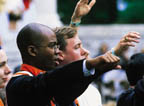
Kenneth Lee '99 gives three cheers for Old Nassau.
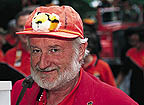
Igor Eberstein *64 was one of hundreds of returning graduate alumni.
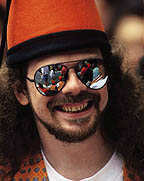
Roger Morrison '85 in shades and a fez.

Surf's up for '95ers Alison Roberts, Karlyn Johnson, and Akira Bell Johnson.
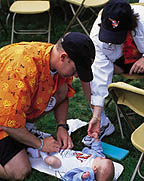
Ch-ch-ch-changes: Lisa LaCourse '90 and her husband take time out for nine-week-old Lucy.
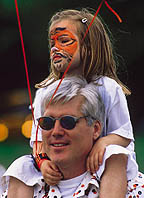
Kendal has a great view on the shoulders of her dad, Ken Barrett '80.

Brad Thompson '75 takes it in while classmate Ted Kaczmar gets it on video.

Clint Bush '70 and his guest, Adair Alspach, salute the crowd.

Bob Biondino '65 chats with Reno Tyrer '65 at their 35th.
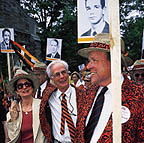
Thomas Baskett '60 and John Stevens '60 can't believe then and now.

Lee Neuwirth '55 *59 hails a pal.

Charlie Saunders '50, Bob Tyler '50, Chris Christensen '50, and Tex Lamason '50 celebrate
50 years.

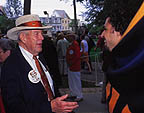
Left: J. B. Smith '45 *47 greets a banner bearer. Right: Jack Geisel '40 catches up with Larry Morris '40.

Back inside the gates are 1935 classmates Jack Brown, Ed Fucik, Bill Lisle, Bob McEwen, Johnny Barrett, and Henry Mayer.

The Class of 2000 parties it up.
 Unlike last year, there was no surprise marriage proposal, but 1,730
undergraduates and graduate students still had plenty to celebrate at Princeton's
273rd Commencement, held May 30 under cloudy skies.
Unlike last year, there was no surprise marriage proposal, but 1,730
undergraduates and graduate students still had plenty to celebrate at Princeton's
273rd Commencement, held May 30 under cloudy skies. Kenneth Shaitelman, a classics major from Great Neck, New York, delivered
the traditional Latin address. In addition to the usual jokes and sly placement
of familiar Latin phrases, Shaitelman quoted the Roman poet Horace: "The
years as they come bring many agreeable things with them; as they go, they
take many away." "As we walk together through FitzRandolph Gate,"
Shaitelman said in the ancient tongue, "I urge you to remember these
wise words and cherish your days at Princeton."
Kenneth Shaitelman, a classics major from Great Neck, New York, delivered
the traditional Latin address. In addition to the usual jokes and sly placement
of familiar Latin phrases, Shaitelman quoted the Roman poet Horace: "The
years as they come bring many agreeable things with them; as they go, they
take many away." "As we walk together through FitzRandolph Gate,"
Shaitelman said in the ancient tongue, "I urge you to remember these
wise words and cherish your days at Princeton." Valedictorian Andrew Houck, an electrical engineer from Colts Neck,
New Jersey, focused his speech on growth, using the campus trees as a central
metaphor. "There is a Greek proverb," Houck said, "'A society
grows great when old men plant trees in whose shade they will never sit.'
We celebrate today underneath the boughs of great trees; those who planted
them only felt an imaginary shade as they toiled with small branches. .
. . I would encourage all of us not to spend our entire lives lounging in
our ancestors' shade, but to venture out into the sun ourselves, ensuring
a well-shaded future for the comfort of those to come."
Valedictorian Andrew Houck, an electrical engineer from Colts Neck,
New Jersey, focused his speech on growth, using the campus trees as a central
metaphor. "There is a Greek proverb," Houck said, "'A society
grows great when old men plant trees in whose shade they will never sit.'
We celebrate today underneath the boughs of great trees; those who planted
them only felt an imaginary shade as they toiled with small branches. .
. . I would encourage all of us not to spend our entire lives lounging in
our ancestors' shade, but to venture out into the sun ourselves, ensuring
a well-shaded future for the comfort of those to come."
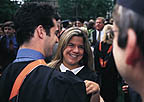 President Shapiro conferred degrees on 929 bachelors of arts and 171
bachelors of science in engineering in the Class of 2000, and upon five
graduates from earlier classes. The University also awarded 625 advanced
degrees.
President Shapiro conferred degrees on 929 bachelors of arts and 171
bachelors of science in engineering in the Class of 2000, and upon five
graduates from earlier classes. The University also awarded 625 advanced
degrees.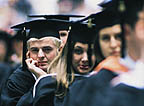 Shapiro ended the ceremony with an address on moral anxiety, a topic
that reflected a year in which students, alumni, and the public debated
bioethics. "The purpose of my brief remarks is to suggest that such
moral anxiety and ethical controversy are essential to the dynamic evolution
of our society, and that each of us should consider them as welcome companions
on our life's journey," Shapiro said. "I believe, therefore, that
a certain anxiety about society's current circumstance is a necessary ingredient
of both a thoughtful life and our capacity to imagine a better future."
Shapiro ended the ceremony with an address on moral anxiety, a topic
that reflected a year in which students, alumni, and the public debated
bioethics. "The purpose of my brief remarks is to suggest that such
moral anxiety and ethical controversy are essential to the dynamic evolution
of our society, and that each of us should consider them as welcome companions
on our life's journey," Shapiro said. "I believe, therefore, that
a certain anxiety about society's current circumstance is a necessary ingredient
of both a thoughtful life and our capacity to imagine a better future." In conclusion, he said, "In the midst of all the change, challenge,
and anxiety, let me assure you that there is one thing that we are not anxious
about-and that is how ready and able you are to undertake this task, to
push forward the boundaries of both knowledge and understanding. . . . I
congratulate you all on your wonderful achievements as students and thank
you for the contributions you have already made to our shared academic and
moral life here on campus. . . . Good luck and Godspeed on the next step
of your journey."
In conclusion, he said, "In the midst of all the change, challenge,
and anxiety, let me assure you that there is one thing that we are not anxious
about-and that is how ready and able you are to undertake this task, to
push forward the boundaries of both knowledge and understanding. . . . I
congratulate you all on your wonderful achievements as students and thank
you for the contributions you have already made to our shared academic and
moral life here on campus. . . . Good luck and Godspeed on the next step
of your journey."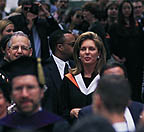 Queen Noor of Jordan, formerly Lisa Halaby '73, walks with President
Shapiro toward the university chapel, where she gave the baccalaureate address
on Sunday, May 28. Noor, who studied architecture and urban planning at
Princeton, met her late husband, King Hussein, while working on an urban-planning
project in Jordan. In her address, she focused on the need for public service,
and she commended the Class of 2000 for its 75 community service initiatives.
She charged the class, "As you have been enriched, so must you enrich
others." Princeton's baccalaureate address is one of the university's
oldest traditions; the first was delivered by President Samuel Davies in
1760 and was called "Religion and Public Spirit."
Queen Noor of Jordan, formerly Lisa Halaby '73, walks with President
Shapiro toward the university chapel, where she gave the baccalaureate address
on Sunday, May 28. Noor, who studied architecture and urban planning at
Princeton, met her late husband, King Hussein, while working on an urban-planning
project in Jordan. In her address, she focused on the need for public service,
and she commended the Class of 2000 for its 75 community service initiatives.
She charged the class, "As you have been enriched, so must you enrich
others." Princeton's baccalaureate address is one of the university's
oldest traditions; the first was delivered by President Samuel Davies in
1760 and was called "Religion and Public Spirit."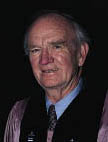 Val Logsdon Fitch, Doctor of Science
Val Logsdon Fitch, Doctor of Science Mae C. Jemison, Doctor of Humanities
Mae C. Jemison, Doctor of Humanities Wendy Kopp '89, Doctor of Humanities
Wendy Kopp '89, Doctor of Humanities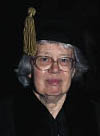 Mary F. Lyon, Doctor of Science
Mary F. Lyon, Doctor of Science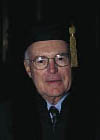 Gordon E. Moore, Doctor of Laws
Gordon E. Moore, Doctor of Laws